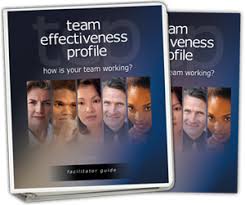TEAM EFFECTIVENESS PROFILE (TEP)

by Christine Glaser, Rollin Glaser, and the HRDQ Development Team
Available in both Online and Paper-Based Format
Help teams learn how to surface, diagnose, and work through the issues that impede effective teamwork. For more than 15 years, the Team Effectiveness Profile (TEP) has helped teams eliminate or reduce blockages in the 5 vital areas of team activity: Mission, Vision, and Goals; Team Roles; Operating Processes; Interpersonal Relationships; Interteam Relationships.
Learning Outcomes
- Identify issues that block effectiveness
- Reduce or eliminate problems that can drain a group’s energy
- Maximize the group’s productive efforts
Theory
The Team Effectiveness Profile focuses on the 5 Categories of Team Effectiveness. The first 4 of these categories are based on those presented by Richard Beckhard in Organization Development: Strategies and Models (1969). Interteam relationship theory is the basis for the fifth category.
5 Categories of Team Effectiveness
- Mission, Vision and Goals
- Team Roles
- Operating Processes
- Interpersonal Relationships
- Interteam Relationships
How It Works
The TEP has been designed to function as a self-administered learning instrument. The TEP yields an overall Team Effectiveness Score as well as separate scores for each of the 5 areas indicating the general health of the group and blockages that hinder team effectiveness.
Uses for the TEP
Appropriate for any type of team and all levels of team members and leaders, the TEP can be used as a stand-alone instrument or as a component in a larger team-building programme. The TEP can be used to:
- Measure pre-team building conditions
- Orient new teams to potential problems
- Unblock struggling teams
- Determine post- team-building results
We recommend administering the TEP periodically, as issues will change over a period a time.
What to Order/Product Contents
Order one Facilitator Guide per trainer and one Participant Guider per participant.
Facilitator Guide includes:
- Administrative guidelines
- Team development theory
- Experiential learning methodology
- Normative and reliability data
- Sample copy of the Participant Guide
- 2-hour workshop
- 6 optional activities
- 2 alternative training designs
- Overhead transparency masters
- Reproducible participant handouts
- Reproducible article Building a Winning Team
- CD-ROM containing all reproducible materials, certificate of achievement, training evaluation, PowerPoint presentation
- Convenient binder format
Participant Guide includes:
- 50-item profile
- Pressure-sensitive scoring form
- Interpretive information
- Descriptions of the 5 team effectiveness areas
- Discussion guide
- Action planning